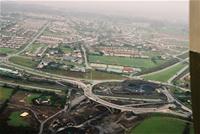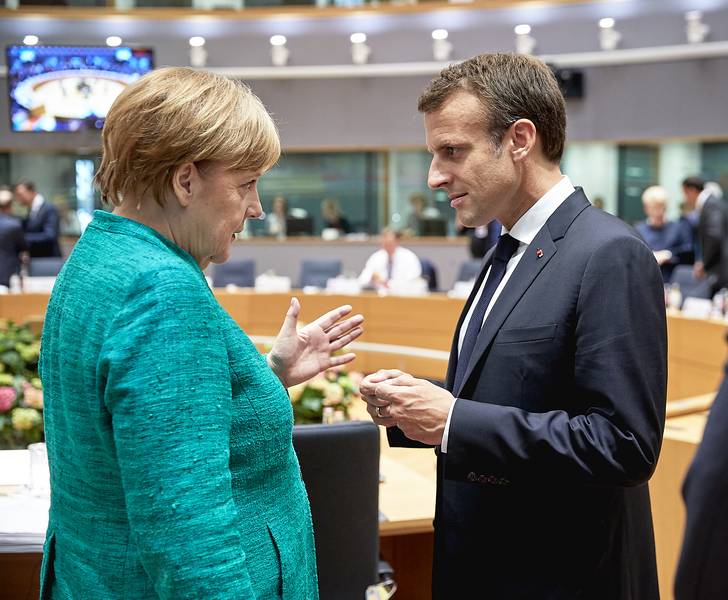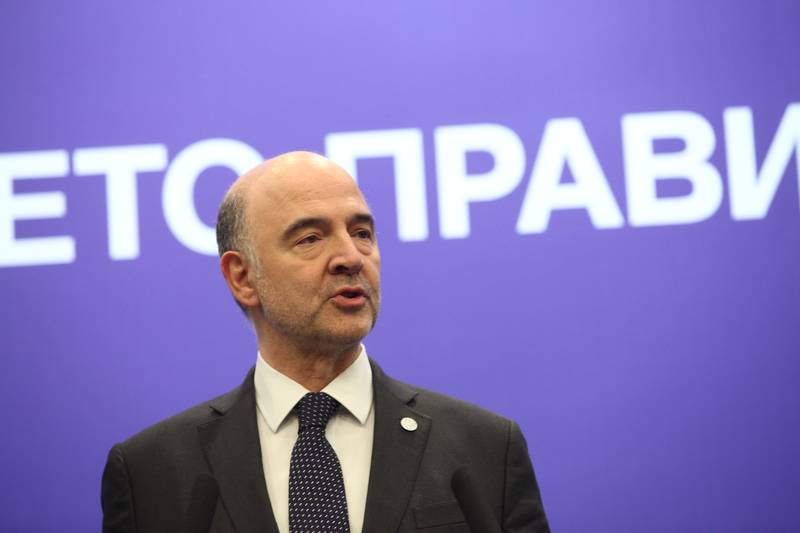Ireland: The miracle is over, let's get to work
Ralitsa Kovacheva, December 2, 2010
 Over the next four years Ireland has to adjust its budget by 15 billion euro - that's the gap between revenues and expenditure, which is forcing the country to keep raising external financing at increasing rates. An additional difficulty is financing the banks, severely affected by the financial crisis, which threatened to lead the country to a record high deficit.
Over the next four years Ireland has to adjust its budget by 15 billion euro - that's the gap between revenues and expenditure, which is forcing the country to keep raising external financing at increasing rates. An additional difficulty is financing the banks, severely affected by the financial crisis, which threatened to lead the country to a record high deficit.
Ultimately, the Irish government decided to take a loan from the EU and the IMF. One of the preconditions was, however, the EU to approve Ireland's 4-year budgetary strategy, which describes in details all the measures, aiming to stabilise public finances and to achieve economic growth.
What is happening now cannot not continue, is maybe the most used phrase in the  140-page document: “The current level of borrowing is unsustainable. Unless it is reduced, the burden of debt service will absorb a rapidly increasing proportion of tax revenue, even assuming no upward pressure on interest rates. More pertinently, as recent developments in the international bond markets have shown, persisting with the current scale of borrowing will result in interest rates remaining at unaffordable levels.”
140-page document: “The current level of borrowing is unsustainable. Unless it is reduced, the burden of debt service will absorb a rapidly increasing proportion of tax revenue, even assuming no upward pressure on interest rates. More pertinently, as recent developments in the international bond markets have shown, persisting with the current scale of borrowing will result in interest rates remaining at unaffordable levels.”
According to government’s calculations, servicing the interest on the national debt will cost 15 percent of the tax revenues in 2011 and that percentage will increase to 20% in 2014.
What is the current picture?
According to November 2010 data, the budget deficit for 2010 is 11.7% and the public debt - 69% of GDP, but the speed of its growing is high (it will exceed 100% over the next two years). The unemployment is 13.5% and there is a current account deficit due to declining export - a key engine of the economy - which is recovering more slowly than expected.
The objectives set out in the programme are: by 2014 the average economic growth to reach 2.75%, the budget deficit to fall below 3% of GDP, the debt not to exceed 100% of GDP, the unemployment to fall below 10% and the current account of the balance of payments to go on surplus yet in 2011.
How will this happen?
The 4-year plan includes a package of measures with a general consolidation effect of 15 billion euro. Two-thirds of the amount (about 10 billion euro) will come from costs reduction (7 billion by cutting current expenditures and 3 billion - by cutting capital expenditure), while one third (5 billion) will come from revenue increase. A drastic cut - by 40% of the total, or 6 billion euro, will be reached as early as 2011.
Costs reduction, however, will be done with a clear vision for the direction in which the economy has to develop. “The careful funding choices made in this Plan seek to protect core areas of economic investment such as education and supports for enterprise and innovation for the development of the smart economy. Investment in key social infrastructure such as public transport, hospitals, schools, water and environmental services will also be maintained.”
Secondly, the corporate tax will remain at a level of 12.5% and will not be increased under any circumstances, because "this is a cornerstone of our pro-enterprise, outward-looking industrial policy and has remained consistent over successive administrations.” I'd like to see this written in some Bulgarian strategic document.
Public expenditure
Since 2007, the national income has fallen by 15% and the tax revenues have reduced from over €47 billion to €31.5 billion and are now back to 2003 levels. Meanwhile, from 2000 to 2008 the social welfare expenditure have increased by 160%, education expenditure – by 128%, health expenditure by 186% and overall public expenditure - by 141%. In 2010, one third of public spending goes for payment of salaries and pensions, and 34% - for social protection. Although the government has already made cuts by more than 10 million euro in the last two years, the current levels of public spending continue to be unaffordable.
That’s why the current expenditure have to be shrunk by 7 billion euro by 2014, the cost of public sector wages has to be reduced by 1.2 billion euro, the cost of social protection – by 2.8 billion euro, and other programme expenditure by 3 billion euro. Public sector employees must be reduced by 25 thousand people. Of nearly 300,000 people employed in the public service sector, most are employed in healthcare - 106,850 and in education - 93,700. A curious parallel with Bulgaria can be done with the number of police officers (Gardaí) - 14,500 people, given the population of Ireland is 4.2 million, while the Bulgarian Interior Ministry has about 60,000 employees of more than 7 million people.
Students' contribution to the costs of third level education will be increased and the social welfare expenditure will be reduced. The government is committed to reform the budget system as early as with the 2011 budget and to implement measures for greater efficiency of public services.
Public sector pensions
100 million euro will be saved by reducing the pensions of public employees. The government will introduce a reformed pension scheme for new entrants in the sector of public services and their payment will be reduced by 10%.
Although the demographic profile of Ireland is more favourable than in most European countries, the number of pensioners will rise significantly in coming years, the document reads. Estimated cost of public pensions will increase to 800 million euro or by 16% by 2014. Moreover, only half of workers have private pensions.
Therefore, the retirement age in the public sector will be increased initially to 66 years, and subsequently it will be increased in line with a recently adopted national plan which provides for an increase of the retirement age to 68 years in 2028. However, in 2014 a new supplementary pension scheme will be introduced for employees not covered by the current scheme. Contributions to it will be paid according to the amount of income - workers whose income exceeds a certain threshold will automatically be included in the new scheme with a contribution of 4%.
Minimum wage and social benefits
Currently the minimum wage in Ireland is 8.65 euro per hour. It is “the second highest in absolute terms compared to other EU countries and is sixth when expressed in purchasing power terms. As a percentage of the average gross monthly earnings, Ireland has the sixth highest NMW (National Minimum Wage)“.
The plan provides for a reduction of the minimum wage by one euro to 7.65 euro per hour. Higher minimum wage is reported as damaging to the labour market because it creates obstacles to jobs creation. “Where a NMW is imposed at a level higher than the equilibrium wage rate, unemployment will result. Some workers will be willing to work for a wage lower than NMW but employers are restricted from providing these job opportunities.“
At the same time, the high rate of social welfare payments reduces the incentives for job-seekers. After the reduction in budget 2010, these payments are currently 196 euro per week. The government has estimated that “the persistence of high replacement rates can act as a major disincentive to work. Replacement rates of the order of 70% can be considered to be a barrier to employment.” In fact, couples who both are not working face high replacement rates at income levels up to the average industrial wage and as well as the couples with children who are both not working. So these people simply don’t need to work.
Taxation - and justice for all
45% of Ireland's taxpayers will not pay income tax in 2010 because of various exemptions and privileges. Meanwhile, the number of people subjected to the highest tax rates has been reduced from 23% to 13%, partly because of reduced income. “The overall burden and incidence of income taxation has increasingly fallen on a relatively small number of taxpayers. In 2010 we have reached a point whereby just 8% (earning 75,000 euro or more) will pay 60% of all income tax while almost 80% earning 50,000 euro or less contribute just 17% of income tax.”
This cannot continue, once again the document says. The burden must be shared by all according to their ability, but without any privileged groups. By eliminating or reducing existing exemptions and reliefs the revenue in the Treasury would increase by 775 million euro. The entry point to Income Tax will be reduced to approximately 15,300 euro, a fall of 3,000 euro from 18,300 euro in the 2010 tax year by 2014. This will allow the percentage of people who do not pay income tax to be reduced to 35% -36% from the current 45%. Thanks to the enlarged scope of the income tax, about 2 billion euro will go into the Treasury.
As a result of these tax changes, “Ireland will move from its 2009 position as sixth lowest tax wedge in the OECD to eleventh lowest. Ireland will have the second lowest tax wedge of the EU members of the OECD from its 2009 position of lowest tax wedge.” (First position is for the UK).
A Site Value Tax will be introduced in 2012 and completed by 2013, from which the government is expecting additional 530 million euro. VAT will be increased from 21 to 22% in 2013 and to 23% in 2014, which will bring total revenue of 620 million euro.
A vision for the growth
 The purpose of the 4-year plan is to stabilise the budget, while encouraging economic growth. Therefore, investment in key areas will not be reduced. With a due pride the Irish government notes the achievements so far: “We now have state-of-the-art motorway connections between Dublin and the main regional centres. The expanded capacity levels achieved in infrastructure overall are likely to be sufficient to meet anticipated demand over the medium term in most areas.”
The purpose of the 4-year plan is to stabilise the budget, while encouraging economic growth. Therefore, investment in key areas will not be reduced. With a due pride the Irish government notes the achievements so far: “We now have state-of-the-art motorway connections between Dublin and the main regional centres. The expanded capacity levels achieved in infrastructure overall are likely to be sufficient to meet anticipated demand over the medium term in most areas.”
The plan aims at supporting exports, which in turn are expected to stimulate domestic consumption and job creation. And again: “The conditions for sustainable export-led growth are in place - good infrastructure, high-quality human capital, a favourable taxation environment and available credit for viable businesses.”
Good prospects are compounded by the modern structure of Irish exports - a high proportion of exports from high-tech sectors, for example, by which indicator the country ranks third in the EU after Malta and Luxembourg. The list of priority sectors is also indicative - services, tourism, food industry, education, information and green technologies. By 2014 Ireland will invest 4.843 billion euro in transport, 3.493 in the environment, 2.182 in support of entrepreneurship, 1.883 billion euro in education, 1.587 billion euro in healthcare. For comparison, the cost of social protection for the entire four-year period is only 27 million euro.
The UK and the USA remain Ireland's key markets, but the country is also looking at Brazil, China, India, Russia, Japan and the Gulf States. The ambitions are the country to become a world centre for development of new technologies, research and innovation.
Lessons for Bulgaria
Many analysts argued that Ireland was able to cope alone with its budget problems, even with restructuring the banking sector, if it was not a member of the euro area. The country was literally forced by its partners to ask for external funding to calm the markets and thus "save" Portugal and Spain, who are panting under the interest rates' burden. Furthermore, again because of the euro area membership, the country had less useful ways to solve its banking problems.
Grounds that Ireland was able to do it alone we can also find in the consolidation measures implemented by the government in recent years. Despite them, however, problems accumulated from years of prosperity are not yet resolved. As it is clear from everything above, there are too many privileges and benefits, which the state can no longer pay for. Indeed, it has been long since it is unable to pay, that's why the state is so seriously indebted. The levels of social protection and tax burden are such that despite the elimination of many relieves, they will remain more favourable than those in other European countries.
Intentionally I will not touch the issue (which is favourite to commentators lately), whether it is fair taxpayers to take on the burden of bursting property bubble and bank failures. Government's plan clearly shows that this is not the only problem. The wasteful public hands have contributed significantly to the budget problems. What I really think is important is the analysis of achievements and mistakes, and also the vision for the future.
On the one hand, it is clear that Ireland has managed to use the economic boom to invest in roads, general infrastructure and education (remember how the budget surpluses in recent years in Bulgaria were spent!). That's why the Irish Government  can say with an unconcealed pride that Ireland has a highly educated and skilled workforce. This, coupled with the infrastructure and the low taxes is the basis for future growth. Basis, which makes the ambitious plans to develop innovations and new technologies look completely realistic.
can say with an unconcealed pride that Ireland has a highly educated and skilled workforce. This, coupled with the infrastructure and the low taxes is the basis for future growth. Basis, which makes the ambitious plans to develop innovations and new technologies look completely realistic.
The latter is especially instructive for Bulgaria, which is now making a choice between roads and education. As the Irish experience shows, it is an impossible choice which demonstrates a lack of vision for the future. Because the roads are only the arteries of a single economic organism, which cannot function without a brain.
 Klaus Regling | © Council of the EU
Klaus Regling | © Council of the EU Mario Centeno | © Council of the EU
Mario Centeno | © Council of the EU Mario Centeno | © Council of the EU
Mario Centeno | © Council of the EU Angela Merkel, Emmanuel Macron | © Council of the EU
Angela Merkel, Emmanuel Macron | © Council of the EU Benoit Coeure | © Council of the EU
Benoit Coeure | © Council of the EU Pierre Moscovici | © Council of the EU
Pierre Moscovici | © Council of the EU